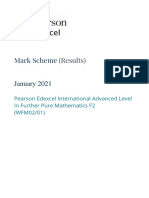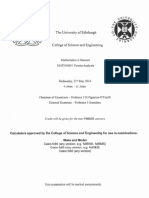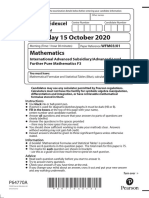0 ratings0% found this document useful (0 votes)
15 views2012:2013
2012:2013
Uploaded by
Loh Jun XianCopyright:
© All Rights Reserved
Available Formats
Download as PDF or read online from Scribd
2012:2013
2012:2013
Uploaded by
Loh Jun Xian0 ratings0% found this document useful (0 votes)
15 views5 pagesCopyright
© © All Rights Reserved
Available Formats
PDF or read online from Scribd
Share this document
Did you find this document useful?
Is this content inappropriate?
Copyright:
© All Rights Reserved
Available Formats
Download as PDF or read online from Scribd
Download as pdf
0 ratings0% found this document useful (0 votes)
15 views5 pages2012:2013
2012:2013
Uploaded by
Loh Jun XianCopyright:
© All Rights Reserved
Available Formats
Download as PDF or read online from Scribd
Download as pdf
You are on page 1of 5
The University of Edinburgh
College of Science and Engineering,
Mathematics 4 Honours
MATH10051 Fourier Analysis
Friday, 24¢ May 2013
9.30- 11.30 am
Chairman of Examiners — Professor J M Figueroa-O’ Farrill
External Examiner ~ Professor J Greenlees
Credit will be given for the best three answers
Calculators approved by the College of Science and Engineering for use in exami
: Make and Model
Casio x85 (any version, e.g. fx85WA, fx85MS)
Casio fx83 (any version, e.g. 1x83ES)
Casio fx82 (any version)
This examination will be marked anonymously.
MATH10051 June 13 MAT-1-FAn
Fourier Analysis
‘Throughout this paper, the word ‘integrable’ means bounded and Riemann integrable
(as in lectures).
1. We denote by T the circle R/Z.
{a) Let f: T+ C be an integrable function and k € Z. Define the Fourier coefficient
F(k). {1 mark]
(b) Give examples to show the following. You do not need to justify your answers.
(i) There exist integrable functions f, 9: T > C such that f and g are equal almost
everywhere, f is continuous, and g is not continuous. [1 mark]
(ii) There exist integrable functions f, 9: T+ C such that f(k) = g(k) for all k € Z
but f #9. [1 mark]
(ii) There exist an integrable function f: T + € and a point t € T such that
(Snf)(t) does not converge to f(t) as n + oo. (Here Spf denotes the nth
Fourier partial sum of f.) (1 mark}
(0) Let J, fis fos--- + [0,1) + C be integrable functions.
(i) Prove that if f, > f uniformly then f, + f pointwise. (2 marks]
(ii) Prove that if f, + f uniformly then f, > f in {ff (2 marks]
(ii) Give an example to show that (/,) may converge to f pointwise but not
uniformly, explaining your reasons. [4 marks]
(a) Let f: {0,1] > R be an intograble function such that f(t) > 0 for all t € (0,1)
and fj f(t)dt = 0. Prove that f(z) = 0 for every point x € [0,1] such that f is
continuous at 2. [5 marks}
(¢) Prove that there is no continuons fimetion 6: [-1/2,1/2] —* R with the follo
property: for all continuous functions f: [-1/2,1/2] R,
iB
1/2
F(}S(E) dt = FO):
(2
[8 marks]
(a) What is a trigonometric polynomial? (If you use any nonstandard notation in your
answer, you should define it.) [2 marks]
(b) Let f: T+ C be an integrable function. Denote by Sf the nth Fourier partial sum
of f.
(i) Let n > 0. Prove that ||f —SnJ'll2 || f — gll2 for all trigonometric polynomials
9 of degree less than or equal to n. (5 marks}
(ii) Deduce that the sum S)f2_,. |/(k)[? converges. [5 marks]
(c) A positive approximation to delta is a sequence (K,)°2.9 of integrable functions T + C
satisfying:
PADI K,(¢) > 0 for all n > 0 and ¢€T;
PAD2 J, K,(t) dé = 1 for all n > 0;
PADS limy-soo frepjer/a Kall) dt = 0 for all 4 € (0, 1/2)
(i) Let (,) be a positive approximation to delta and let f: T + C be an integrable
fimetion. Prove that f* Ky — J in |]; where * denotes convolution. (The
proof in lectures used a certain general theorem on integrable funetions; you
may use this without proof as long as you state it precisely.) {10 marks]
(ii) Give two examples of positive approximations to delta, without proof. (You
may use standard terminology.) [8 marks}
3. In this question, S,,f denotes the nth Fourier partial sum of a function f. Given k € Z,
we write e,: T+ C for the function given by ex(t) =e" (t€ 7)
(a) Explain why it is not the case that Sf — f uniformly for all integrable functions
(Toc [2 marks]
(b) Let (cz). be a double sequence of complex numbers. Suppose that 2. [onl <
co. Prove that there is a continuous function g: T —+ € such that Diy Chee > 9
uniformly as 2 + 00. {7 marks}
(c) Prove that for alln >0, f €C™(T) and ke Z,
POW = nik"),
where f) denotes the nth derivative of f. [4 marks]
(@) Let f: TC be a continuously differentiable function. Prove that S7—_.. [f(#)| <
co. (You may use theorems from the lectures if they are clearly stated.) [5 marks}
(©) (i State, without proof, Fejér’s theorem on Fourier series of continuous functions.
(You need only give the continuous case, but you should define any notation or
terminology you introduce.) [3 marks]
(i) Briefly sketch the proof. Only the key steps need be given, and you are not
required to prove any results about positive approximations to delta,
[4 marks}
(a) Let (tn) be a sequence in [0, 1)
() What does it mean for (tn) to be equidistributed? [2 marks}
(i) Prove directly from the definition that the sequence (2-")22., is not equidistributed.
{2 marks]
(iii) Suppose that for all k eZ,
fa :
Lynas [ea
n h
as n+ oo. Prove that for all continuous functions f : T + C,
Sdue= [sow
im
as n+ 00. (You may use a theorem from lectures on trigonometric polynomial
approximations to continuous functions.) (7 marks}
(iv) Given an example of an equidistributed sequence in (0, 1), without proof.
(2 marks}
(b) Let @ be a finite abelian group.
(i) Prove that the characters of G are orthonormal. [6 marks]
(i) The set of all functions G + C forms a vector space over C. Prove that its
dimension is equal to the number of elements of G. [6 marks]
You might also like
- The Subtle Art of Not Giving a F*ck: A Counterintuitive Approach to Living a Good LifeFrom EverandThe Subtle Art of Not Giving a F*ck: A Counterintuitive Approach to Living a Good LifeRating: 4 out of 5 stars4/5 (6023)
- The Gifts of Imperfection: Let Go of Who You Think You're Supposed to Be and Embrace Who You AreFrom EverandThe Gifts of Imperfection: Let Go of Who You Think You're Supposed to Be and Embrace Who You AreRating: 4 out of 5 stars4/5 (1132)
- Never Split the Difference: Negotiating As If Your Life Depended On ItFrom EverandNever Split the Difference: Negotiating As If Your Life Depended On ItRating: 4.5 out of 5 stars4.5/5 (910)
- Grit: The Power of Passion and PerseveranceFrom EverandGrit: The Power of Passion and PerseveranceRating: 4 out of 5 stars4/5 (628)
- Hidden Figures: The American Dream and the Untold Story of the Black Women Mathematicians Who Helped Win the Space RaceFrom EverandHidden Figures: The American Dream and the Untold Story of the Black Women Mathematicians Who Helped Win the Space RaceRating: 4 out of 5 stars4/5 (937)
- Shoe Dog: A Memoir by the Creator of NikeFrom EverandShoe Dog: A Memoir by the Creator of NikeRating: 4.5 out of 5 stars4.5/5 (547)
- The Hard Thing About Hard Things: Building a Business When There Are No Easy AnswersFrom EverandThe Hard Thing About Hard Things: Building a Business When There Are No Easy AnswersRating: 4.5 out of 5 stars4.5/5 (358)
- Her Body and Other Parties: StoriesFrom EverandHer Body and Other Parties: StoriesRating: 4 out of 5 stars4/5 (831)
- Elon Musk: Tesla, SpaceX, and the Quest for a Fantastic FutureFrom EverandElon Musk: Tesla, SpaceX, and the Quest for a Fantastic FutureRating: 4.5 out of 5 stars4.5/5 (481)
- The Emperor of All Maladies: A Biography of CancerFrom EverandThe Emperor of All Maladies: A Biography of CancerRating: 4.5 out of 5 stars4.5/5 (275)
- The Little Book of Hygge: Danish Secrets to Happy LivingFrom EverandThe Little Book of Hygge: Danish Secrets to Happy LivingRating: 3.5 out of 5 stars3.5/5 (434)
- The Yellow House: A Memoir (2019 National Book Award Winner)From EverandThe Yellow House: A Memoir (2019 National Book Award Winner)Rating: 4 out of 5 stars4/5 (99)
- The World Is Flat 3.0: A Brief History of the Twenty-first CenturyFrom EverandThe World Is Flat 3.0: A Brief History of the Twenty-first CenturyRating: 3.5 out of 5 stars3.5/5 (2281)
- Devil in the Grove: Thurgood Marshall, the Groveland Boys, and the Dawn of a New AmericaFrom EverandDevil in the Grove: Thurgood Marshall, the Groveland Boys, and the Dawn of a New AmericaRating: 4.5 out of 5 stars4.5/5 (273)
- The Sympathizer: A Novel (Pulitzer Prize for Fiction)From EverandThe Sympathizer: A Novel (Pulitzer Prize for Fiction)Rating: 4.5 out of 5 stars4.5/5 (125)
- A Heartbreaking Work Of Staggering Genius: A Memoir Based on a True StoryFrom EverandA Heartbreaking Work Of Staggering Genius: A Memoir Based on a True StoryRating: 3.5 out of 5 stars3.5/5 (233)
- Team of Rivals: The Political Genius of Abraham LincolnFrom EverandTeam of Rivals: The Political Genius of Abraham LincolnRating: 4.5 out of 5 stars4.5/5 (235)
- On Fire: The (Burning) Case for a Green New DealFrom EverandOn Fire: The (Burning) Case for a Green New DealRating: 4 out of 5 stars4/5 (75)
- FP22021 Jan IAL MSDocument22 pagesFP22021 Jan IAL MSLoh Jun Xian100% (1)
- The Unwinding: An Inner History of the New AmericaFrom EverandThe Unwinding: An Inner History of the New AmericaRating: 4 out of 5 stars4/5 (45)
- Assignment 7Document3 pagesAssignment 7Loh Jun XianNo ratings yet
- The University of Edinburgh College of Science and EngineeringDocument13 pagesThe University of Edinburgh College of Science and EngineeringLoh Jun XianNo ratings yet
- Lecture NotesDocument73 pagesLecture NotesLoh Jun XianNo ratings yet
- Galois Theory: MATH10080Document2 pagesGalois Theory: MATH10080Loh Jun XianNo ratings yet
- The University of Edinburgh College of Science and EngineeringDocument3 pagesThe University of Edinburgh College of Science and EngineeringLoh Jun XianNo ratings yet
- Assignment 2Document3 pagesAssignment 2Loh Jun XianNo ratings yet
- 2015:2016Document5 pages2015:2016Loh Jun XianNo ratings yet
- The University of Edinburgh College of Science and EngineeringDocument5 pagesThe University of Edinburgh College of Science and EngineeringLoh Jun XianNo ratings yet
- 2013:2014Document5 pages2013:2014Loh Jun XianNo ratings yet
- 2011:2012Document5 pages2011:2012Loh Jun XianNo ratings yet
- Problem Sheet 2 (For Tutorials in Week 4)Document2 pagesProblem Sheet 2 (For Tutorials in Week 4)Loh Jun XianNo ratings yet
- 2015Document5 pages2015Loh Jun XianNo ratings yet
- 2017Document5 pages2017Loh Jun XianNo ratings yet
- Lecture NoteDocument135 pagesLecture NoteLoh Jun XianNo ratings yet
- 16MT AnalysisI WebnotesallDocument57 pages16MT AnalysisI WebnotesallLoh Jun XianNo ratings yet
- FP2C7 Maclaurin and Taylor SeriesDocument2 pagesFP2C7 Maclaurin and Taylor SeriesLoh Jun XianNo ratings yet
- Essential Calculus. Early Transcendentals Formulae Booklet 2Document10 pagesEssential Calculus. Early Transcendentals Formulae Booklet 2Loh Jun XianNo ratings yet
- FP2C8 Polar Coordinates 210221 OnlineDocument3 pagesFP2C8 Polar Coordinates 210221 OnlineLoh Jun XianNo ratings yet
- Problem Sheet 1 (For Tutorials in Week 3)Document2 pagesProblem Sheet 1 (For Tutorials in Week 3)Loh Jun XianNo ratings yet
- F32021 JanDocument36 pagesF32021 JanLoh Jun Xian0% (1)
- FP3C1Hiperbolic Functions 210214Document3 pagesFP3C1Hiperbolic Functions 210214Loh Jun XianNo ratings yet
- Accelerated Algebra and Calculus For Direct Entry 2015Document17 pagesAccelerated Algebra and Calculus For Direct Entry 2015Loh Jun XianNo ratings yet
- FP32020 Oct IALDocument32 pagesFP32020 Oct IALLoh Jun XianNo ratings yet
- wch06 01 Que 20190516Document16 pageswch06 01 Que 20190516Loh Jun XianNo ratings yet
- FP22021 JanDocument32 pagesFP22021 JanLoh Jun XianNo ratings yet
- F32021 Jan MSDocument27 pagesF32021 Jan MSLoh Jun XianNo ratings yet
- FP32020 Oct IAL MSDocument20 pagesFP32020 Oct IAL MSLoh Jun XianNo ratings yet
- WFM02 Oct 2020 QPDocument28 pagesWFM02 Oct 2020 QPLoh Jun Xian100% (1)
- Ial Maths Fp3 RE2Document61 pagesIal Maths Fp3 RE2Loh Jun XianNo ratings yet






































































